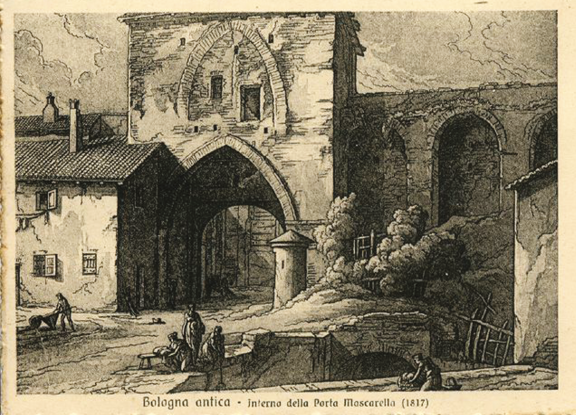The enigmatic name of the Teatro dell'Antico Corso delle Maschere, which opened on via Mascarella in 1831, derives perhaps from the name of the street, via Mascarella, where according to tradition the parade of masks passed during carnival.
This elegant and comfortable (although short-lived) theater presented highly artistic shows with puppets created and manipulated by expert artisans and puppeteers who present low-cost miniature reproductions of pantomimes, dances, opere buffe, comedies, and operas, all accompanied by a small orchestra, with live actors and singers (usually hidden) behind the stage. In these performances, the puppeteers – true artists – itinerant, as were the singers, traveled the world with their puppets, costumes, equipment, and sets. And just like real opera companies, they organized tours in cities that had the “right” spaces. In 19th-century Bologna, only 3 locations were officially authorized to sell tickets to this type of performance: the Nosadella Theater, the St. Gregory Theater, and the Theater of the Ancient Parade of Masks.

Here, on sets provided and mounted by important local decorators and painters (such as Sangiorgi, Bragaldi, Conti, Fantoni, Madrigali, Ruggi, Fazioli, Dall’Aglio, Zanolini, Palazzi, Bruwer, and Albe), the first performance, by the puppeteer Antonio Grandi, was given in the spring of 1832.
The show, “colle marionette all’uso di Napoli” (roughly, “with puppets Naples-style”), was the vaudeville entitled “La nuova pianella perduta fra la neve” (“The new slipper lost in the snow”), with music by Carlo Cappelletti, who also wrote the dance “The Lost Monkey,” which, as written in the journal “Teatri Arti e Letteratura,” is full of characters, sets, mechanisms, and costumes, as well as conducted by a fine artist with a full professional orchestra.”
In 1835, this journal expressed admiration for the location, where “the lighting is complete and well-arranged, from the entrance to inside the theater,” and for the program, in which every performance is preceded by “a symphony, always followed by new concertos played by young talents, that would be suitable in other theaters much larger than this one.”
That year also saw the highly successful pièce Caterina di Colunga, “a grand and splendid dance, in perfect Russia costume with over a hundred figures in motion, and two mechanical figures moving without wires, one of the Moletta and the other to be invited”. In addition to the dance, the public even went wild for Bellini’s “Norma,” a show never before presented with puppets.”
The program was full of all sorts of entertainment, created with what the newspapers called “mechanical art,” such as, for example, “a new machine of phantasmagoria, with figures that seem to move around the theater,” or ones that sing arias and dance folk dances, all contributing to the show’s success, performed with precision and elegance, with no expense spared, and receiving the warmest applause.
Unfortunately, despite public acclaim, the excellence of all concerned, and uninterrupted success, the theater had a very short life and closed for good right after that historic performance during the 1836 carnival.

.jpg)



.png)